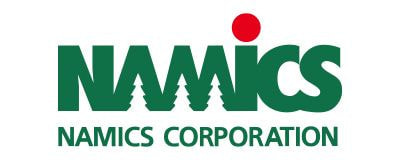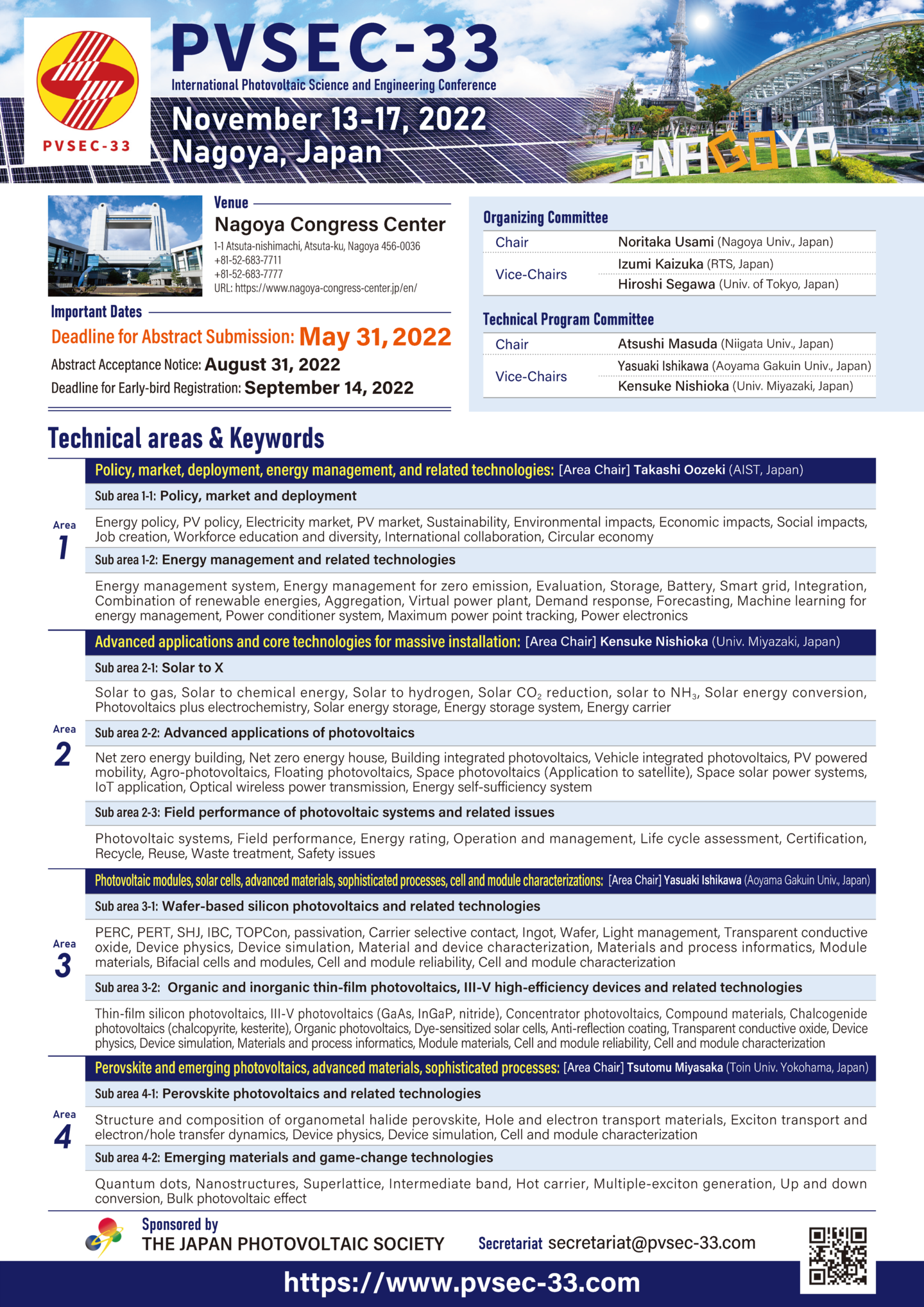Scope

Scope

Message from Program Chair
PVSEC-33 welcomes papers from all the areas relevant to photovoltaic science and technology such as fundamental physics and chemistry, cell and module technologies, characterization techniques, system integrations, policy and market issues, and so on. Many contributed papers from all over the world, together with plenary and invited papers are indispensable to the success of PVSEC-33.

Prof. Atsushi Masuda
The characteristic themes of PVSEC-33 are “extension” and “integration” for the new era of photovoltaics.
Area 1 and area 2 cover the theme of “extension”.
Area 3 and area 4 are based on the theme of “integration”. Instead of separate sessions for different materials systems or for cell- and module-scale technologies, we wish integrate common topics from different fields into shared sessions to facilitate the exchange of ideas.
Area 1 focuses on topics necessary for the continued long-term success of the photovoltaic industry and extension of the industry towards a 100% renewable energy and carbon neutral society. Sub-area 1-1 focuses on the political, governmental, and financial solutions for future PV deployment and strategies for environmental sustainability and social responsibility. Sub-area 1-2 focuses on energy management technologies, including supply-demand balance and forecasting.
Area 2 focuses on the extension of photovoltaic technologies to new applications. Sub-area 2-1 “Solar to X” focuses on the development of photovoltaic technologies for the conversion of solar energy to chemical energy. In sub-area 2-2 and the special sessions, we discuss key technologies for early achievement of carbon neutral and zero-emission society such as ZEB, ZEH, BIPV, and VIPV.
Area 3 focuses on established wafer-based Si, high-efficiency III-V, and inorganic and organic thin film photovoltaics.
Area 4 focuses on emerging technologies such as perovskites and novel device concepts including quantum dots, hot carriers, up- and down-conversion, etc.
Scope
Area 1
Policy, market, deployment, energy management, and related technologies
[Area Chair] Takashi Oozeki (AIST, Japan)
Sub area 1-1
Policy, market and deployment
[KEYWORD] Energy policy, PV policy, Electricity market, PV market, Sustainability, Environmental impacts, Economic impacts, Social impacts, Job creation, Workforce education and diversity, International collaboration, Circular economy
The goal of this sub-area is to address and discuss aspects required to ensure the long-term success of the PV industry. Toward 100% renewable electricity and carbon-neutral society, this sub-area focuses on strategies to sustain or accelerate high PV growth rates and rapid cost reductions through government, policy, and financing models that are critical to the success of PV deployment. A circular economy for PV modules, components, and systems is becoming increasingly important as deployments continue to grow and may have significant benefits for a more resilient and diverse supply chain at all stages. This sub-area also discusses the environmental sustainability of PV throughout the life cycle including material supply, manufacturing, usage and end-of-life, and social sustainability such as job creation, education and diversity as well as energy access for underserved communities, fostering widespread acceptance of PV power, or upholding indigenous peoples’ rights with regards to PV project development. Furthermore, to overcome current obstacles and achieve further deployment of PV power generation, various international collaborative efforts have been created, and it is expected to produce valuable outputs and outcomes enabling to accelerate PV deployment in global. This sub-area also welcomes to present and discuss potential areas for expanded collaboration.
Sub area 1-2
Energy management and related technologies
[KEYWORD] Energy management system, Energy management for zero emission, Evaluation, Storage, Battery, Smart grid, Integration, Combination of renewable energies, Aggregation, Virtual power plant, Demand response, Forecasting, Machine learning for energy management, Power conditioner system, Maximum power point tracking, Power electronics
The goal of this sub-area is to address the challenges of massive Renewable Energy (RE) integration into the electric power system by discussing a wide range of technologies and methodologies of energy utilization. Measures to solve fluctuation of the Variable RE (VRE) is a topic to increase its massive integration into the electric power system. Energy Storage Systems (ESS) including batteries are one of the solutions. Surplus energy can be charged and shortage can be filled by its discharge. This control can be done by Demand Response (DR) too. The demand side increases or decreases its energy consumption by using the DR signal sent by the transmission and distribution organization. Virtual Power Plant (VPP) is consisting not only demand side but also small-scale power plant such as photovoltaic systems. They are aggregated and controlled to keep supply-demand balance. Forecasting technologies are an important issue, and they can increase the performance of the above controls. Recent high-speed parallel computation increases Machine learning technologies which can be applied to the forecasting and above controls. This sub-area also welcomes Power Conditioning System (PCS), power electronics and Maximum Power Point Tracking (MPPT) control, which are expected to be harmonized with the electric power system in the massive integrated situation. This sub-area focuses on these topics.
Area 2
Advanced applications and core technologies for massive installation
[Area Chair] Kensuke Nishioka (Univ. Miyazaki, Japan)
Sub area 2-1
Solar to X
[KEYWORD] Solar to gas, Solar to chemical energy, Solar to hydrogen, Solar CO2 reduction, Solar to NH3, Solar energy conversion, Photovoltaics plus electrochemistry, Solar energy storage, Energy storage system, Energy carrier
“Solar to X” such as “Solar to Hydrogen”, “Solar to NH3”, and “CO2 reduction” is the conversion technology from solar to chemical energy. “Solar to Hydrogen” and “Solar to NH3” are the representative technology for a large amount of chemical energy storage, and “CO2 reduction” is the key technology of removing CO2 in the atmosphere. Thus, a drastic reduction of greenhouse gases in the atmosphere is expecting using this “Solar to X” technique. The goal of this sub-area is to address the challenges of technical and scientific approaches of the conversion from solar to chemical energy especially using solar cell technology. This sub area will provide the opportunity to discuss across the multi-disciplines such as material science, electrochemistry, mechanical and chemical engineering, and techno-economic analysis toward to establish the renewable energy society. This sub-area also welcomes to discuss all technologies in the field of solar to chemical energy conversion such as direct conversion technique from solar to chemicals.
Sub area 2-2
Advanced applications of photovoltaics
[KEYWORD] Net zero energy building, Net zero energy house, Building integrated photovoltaics, Vehicle integrated photovoltaics, PV powered mobility, Agro-photovoltaics, Floating photovoltaics, Space photovoltaics (Application to satellite), Space solar power systems, IoT application, Optical wireless power transmission, Energy self-sufficiency system
This sub-area seeks to address all relevant aspects of the research and development of the advanced applications of photovoltaics (PVs). As PV installations become more widespread, the deployment of distributed PV applications in markets is attracting a lot of attention because the land is scarce in many countries, at least close to consumption centers. The sub-area welcomes a wide range of distributed and specialty technologies for the applications such as building-integrated PV, vehicle integrated PV, PV powered mobility, agro-PV, floating PV, space PV (satellite application), space solar power systems, IoT applications, optical wireless power transmission, energy self-sufficiency system and other not-traditional PV applications. This includes the papers dealing with cell and module-related topics such as flexible and lightweight PV, colored PV, concentrator PV, mobile solar power, cells for the laser/LED power transfer, indoor PV, and all levels of high-efficiency PVs for the integration in consumer products.
Sub area 2-3
Field performance of photovoltaic systems and related issues
[KEYWORD] Photovoltaic systems, Field performance, Energy rating, Operation and management, Life cycle assessment, Module materials and components, Certification, Recycle, Reuse, Waste treatment, Safety issues
This sub-area will cover an extremely wide range of issues relating to the PV system. The knowledge of analyzed data is significant for the system’s long-term reliability. Yearly data is showing an increase in global temperatures, and testing conditions of quality and safety for PV modules depending on regional climate and location properties should be considered.
For a low carbon society, we need to reduce the installation cost of PV systems while thinking about price competition with other renewable energy sources. We also need the reliability of component materials such as glass, back-sheet, encapsulant, junction box and cable to prevent defects in PV systems. On the other hand, from the point of view of realizing a sustainable world, PV module recycle/reuse technology and waste treatment is one of our issues at the end of their life span.
Developing accurate characterization procedures for novel PV devices such as perovskite solar devices will be essential to boost the entire PV market. Thus, we welcome cross-sectional discussion from researchers in various fields.
Area 3
Photovoltaic modules, solar cells, advanced materials, sophisticated processes, cell and module characterizations
[Area Chair] Yasuaki Ishikawa (Aoyama Gakuin Univ., Japan)
Sub area 3-1
Wafer-based silicon photovoltaics and related technologies
[KEYWORD] PERC, PERT, SHJ, IBC, TOPCon, Passivation, Carrier selective contact, Ingot, Wafer, Light management, Transparent conductive oxide, Device physics, Device simulation, Material and device characterization, Materials and process informatics, Module materials, Bifacial cells and modules, Cell and module reliability, Cell and module characterization
Wafer-based Si photovoltaic technology dominates >95% of the global market share because it provides one of the best balances among efficiency, reliability, and cost. In the scientific community, the past few years have seen tremendous advancements in various types of high-efficiency silicon solar cell architectures in both small and large area devices, which is strongly supported by advanced characterization techniques and modeling. Key enablers have been: (i) the increase in the quality of Si absorbers; (ii) the state-of-the-art carrier-selective passivating contacts; and (iii) the design of light management/metallization for increasing current generation, etc. Advanced cell/module manufacturing technologies such as bifacial, half-cut, large-sized/thinner wafers, and high-density interconnection (tilling, paving, etc.) are also attracting attention for improving the performance and/or reducing the cost. This sub-area covers a number of issues related to the above elements of Si photovoltaics and welcomes scientific and technological contributions particularly aiming at further increasing the power conversion efficiency, performance reliability, and lowering the environmental impact as well as the cost.
Sub area 3-2
Organic and inorganic thin-film photovoltaics, III-V high-efficiency devices and related technologies
[KEYWORD] Thin-film silicon photovoltaics, III-V photovoltaics (GaAs, InGaP, nitride), Concentrator photovoltaics, Compound materials, Chalcogenide photovoltaics (chalcopyrite, kesterite), Organic photovoltaics, Dye-sensitized solar cells, Anti-reflection coating, Transparent conductive oxide, Device physics, Device simulation, Materials and process informatics, Module materials, Cell and module reliability, Cell and module characterization
This sub-area covers a wide research field for photovoltaics based on thin films including organic and inorganic absorbers, and III-V-based high-performance technologies. In conventional conferences, the area on each cell has been prepared for deep discussions. Instead, we attempt to provide a platform for a comprehensive understanding of thin-film photovoltaics through interdisciplinary discussions, including science and technologies for cells and modules. Deposition methods are sometimes the same even for different materials, while charge separation behavior may be different between organic and inorganic solar cells. As seen in perovskite solar cells, the fusion of organic and inorganic may offer new directions. The goal of this sub-area is to make a novel scheme leading developments for higher performance and long-term reliability of cells and modules through discussion on common and different parts in various fields. This sub-area also welcomes recent research trends supported by highly accurate first-principle calculation, state-of-the-art characterization technologies, data science, and advanced device simulation.
Area 4
Perovskite and emerging photovoltaics, advanced materials, sophisticated processes
[Area Chair] Tsutomu Miyasaka (Toin Univ. Yokohama, Japan)
Sub area 4-1
Perovskite photovoltaics and related technologies
[KEYWORD] Structure and composition of organometal halide perovskite, Hole and electron transport materials, Exciton transport and electron/hole transfer dynamics, Device physics, Device simulation, Cell and module characterization
Halide perovskites have attracted attention due to their unique optical and electronic properties. It is certain that they open new areas associated with SDGs such as the next-generation solar cells, EL devices and so on. The session deals with fundamental research on chemical and physical properties of materials, material designs, crystallization process analyses, and their mechanisms. In addition, their device structures including carrier transfer layers and topics regarding their device working principles to give high efficiency and high stability to these devices, such as carrier dynamics, device physics, and device simulations, are discussed. Recent progress on lead-free perovskite devices and tandem devices are also included in this session. From the industrial point of view, processes for making large sizes, module structures, module characterizations, and new application fields are discussed. We hope many researchers with many areas of expertise join this session beyond their research fields and exchange ideas and opinions from various backgrounds for looking to the halide perovskite future.
Sub area 4-2
Emerging materials and game-change technologies
[KEYWORD] Quantum dots, Nanostructures, Superlattice, Intermediate band, Hot carrier, Multiple-exciton generation, Up and down conversion, Bulk photovoltaic effect
Further improvement in solar cell efficiency will continue to play a significant role in the 100% renewable energy transition. This relies on breakthroughs arising from emerging materials and game-changing technologies. Sub-area 4.2 comprises fundamental research and novel device concepts providing a multidisciplinary platform for the dissemination of innovative research findings in next-generation high-efficiency photovoltaics. The goal of this sub-area is for the researchers to communicate research in basic physical, chemical and optical phenomena, in addition to studies of new materials and innovative device designs. This sub-area will provide the opportunity to discuss across the multi-disciplines including new materials for all parts of the photovoltaic device, quantum confined or nanostructured systems such as quantum dots and superlattice, engineered band alignments, intermediate band concepts, multiple-exciton generation (MEG), up and down-conversions, hot-carrier effects and bulk photovoltaic effect, and unconventional PV conversion mechanisms. This sub-area also welcomes researchers with expertise beyond these research fields to exchange ideas and opinions from various backgrounds for looking to the future of next-generation photovoltaics.




























